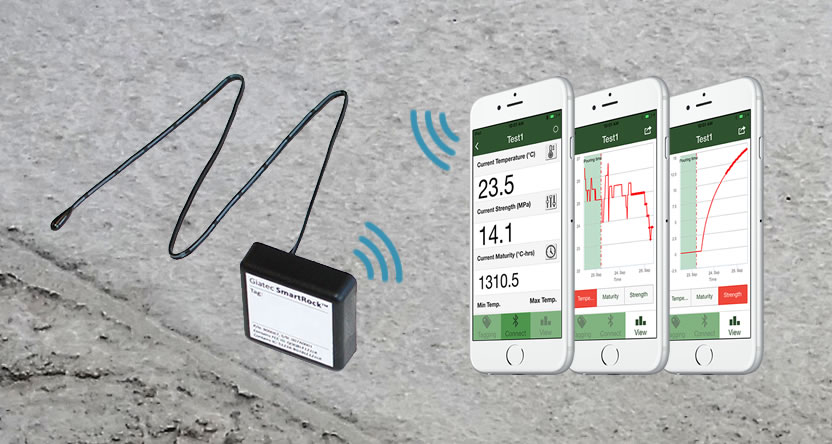An educational video on the concept, measurement, and application of concrete maturity method.
Explore 12 Futuristic Technology Trends Solving Concrete's Biggest Challenges.
Transcript
Hello, My name is Sarah of Giatec Scientific and Today, I am going to discuss the “Maturity Method” for predicting the early age strength of concrete.
So what is it about the “Maturity Method” that interests engineers, researchers, and the construction industry? Measuring the Early age Strength of concrete is important. The reason is that it directly affects the progress of a construction project. In most cases, it is the governing parameter in the speed of the construction. It can also affect the safety margins for moving into the next stage of construction. The strength is also of interest to the structural engineer. That is to verify if certain elements have developed enough strength to be able to carry the next floors load for example.
Construction contractors, on the other hand, want to speed up their progress. They want to know how fast they can proceed to the next level. This can directly affect the time they open the formworks. What we know is that both “Time” and “Temperature” are crucial factors in the strength development of concrete.
As the time passes on and the microstructure of concrete develops, the compressive strength of concrete increases. We also know that the curing regime can directly affect the strength growth in concrete. Concrete subjected to higher temperatures (or pressure as is the case of Autoclave condition) can get to higher strengths in a shorter period of time.
So, if we want to summarize it in simple words, it can be said that the combined effect of time and temperature can be used to study the strength growth of concrete. One can expect that the age of concrete has a significant effect on strength. On the other hand, the temperature history during the curing process of concrete can affect the strength growth. Another key figure which is often considered in studying the strength growth is what’s called “Datum Temperature”. This is the lowest temperature at which strength growth is observed.
In 1949, Nurse proposed that one can correlate the strength development of concrete to the product of temperature and time. However, he did not account for the Datum Temperature effect. Also, he did not measure the concrete temperature; instead he measured the temperature of the curing chamber. In 1951, Saul introduced the term maturity which was correlated with the product of time and temperature. He used the effect of datum temperature in his studies.
The results of this scientific research led to the famous Maturity function that we use today known as – The Nurse-Saul Maturity function. For this purpose, the effect of time intervals with temperatures lower than datum temperature is removed. The function, simply, gives the area between the datum temperature line, and the temperature history.
Saul presented the maturity rule as the following statement:
“ Concrete of the same mix at the same maturity (reckoned in temperature–time) has approximately the same strength whatever combination of temperature and time go to make up that maturity.”
It is worth mentioning that the Nurse-Saul equation is based on the very assumption that the strength gain is a linear function of hydration temperature.
Another method that is used in Maturity calculation is the Equivalent Age method. In this method, an Equivalent Age function is developed, where the equivalent age represents the duration of the curing period at the reference temperature that would result in the same maturity as the curing period at other temperatures. Despite the fact that the Arrhenius function is scientifically more accurate, the Nurse-Saul function is more commonly used by concrete industry because for two reasons:
Number One – The accuracy of the Nurse-Saul function is adequate for most field applications;
& Number two – The Nurse-Saul function is relatively simpler compared with the Arrhenius function.
In order to use the maturity method for predicting the early age strength of concrete, we need to develop the strength to maturity relationships first.
To do so, compressive strength of concrete should be correlated with the temperature history of concrete. The standard procedure to develop such relationships is well described in the ASTM C 1074. According to this standard, 15 cylindrical samples should be prepared for compression test. Specimens should be cured in water or in moist room conditions. Specimens should be tested for compressive strength at different ages: 1,3,7,14, 28 days. At each time, 2 samples should be tested. If the results vary more than 10% from the average value, the third sample will be tested. The temperature variations should be monitored in the curing period. This can be achieved by implementing temperature sensors within concrete cylinders, and monitor the temperature in a regular basis.
ASTM C 1074 requires time intervals of 30 mins (or less) for the first 48 hours and 60 minutes (or less) afterward. This will make it possible to calculate the maturity index. But before that, one should also determine the datum temperature. The procedure for calculating the datum temperature is well described in the standard procedure. When all the measurements are done, we will be able to develop what is called the Strength-Maturity Relationship.
Knowing the datum temperature and temptation variation history, one will be able to measure the maturity index.
For each compressive strength point, the corresponding maturity index is calculated. The compressive strength will be drawn against the logarithm of maturity index for these data points.A linear regression is used to develop the linear equation. The “a” and “b” coefficients will be determined for the best fit. This equation gives the relationship between the maturity, and the compressive strength. It can be used for predicting the early age compressive strength of concrete.
In actual practice, one only needs to know the strength of temperature variation history of concrete to be able to predict the compressive strength.
ASTM C 1074 has standardized the procedure to develop the maturity-strength relationship and strength prediction using the maturity method.
Several Concrete Design codes, such as the ACI 318, and CSA A 23 accept the maturity method as a verified procedure in predicting the early age strength of concrete. This is basically useful when dealing with the opening of the formworks in the construction site.
There are certain commercial devices in the market for measuring the temperature of concrete and the maturity index.
Most of these devices, however, need sophisticated wiring in the structure, and continuous maintenance (as these wires are easily subject to work wear and tear).
Giatec SmartRock takes the maturity measurement in concrete to an all new level. Giatec SmartRock is a wireless sensor which can be embedded in concrete.
It will record and send the temperature measurements directly to the user’s smartphone. A power app is developed for both iOS and Android platforms which can be used to monitor the temperature variations, and measuring the maturity index. By knowing the maturity – strength relationship for a specific mix, the application allows the user to predict the compressive strength of concrete; right at the palm of your hand.
While maturity method provides an easy to use procedure to predict the strength, it has certain limitations. The main obstacle is that the cylindrical specimens used in the lab for developing the maturity-strength relationships is not representative of the in place concrete. This can be because of the changes in materials, water to cement ration, air content, batching method, etc; The other issue with this method is dealing with high temperatures. When the early-age temperatures are very high, it can lead to inaccurate estimation of strength at later ages; Another challenge in the practice is determining a reliable datum temperature. Using a datum temperature (with the Nurse-Saul function) that is not representative of the concrete mixture can result in incorrect estimation of strength.
In the next few slides, We will briefly explain how maturity measurement is done in an actual field practice. The temperature sensor is placed in different locations in the concrete element. The location is selected based on the vulnerability of the element to failure at the time of removing the formworks.
The measurements can get started as soon as the concrete is placed in the formwork. This is know as the pouring time. The temperature variations will be monitored during the curing of the concrete element. Based on the temperature history and by knowing the datum temperature, one can measure the maturity index at any given time. The maturity index can be used to predict the early age strength of concrete. For this purpose, you will need a maturity-strength relationship for the mix that is used. This relationship can be derived from the method described earlier in this presentation.
If you want to learn more about the maturity method, please visit the provided link or contact Giatec Scientific’s support department
Thank you for watching this presentation.
| You may also be interested in this: SmartRock®, a novel wireless sensor developed by Giatec, can be utilized to monitor the temperature of concrete and calculate the real-time strength of concrete based on the maturity concept. Learn more about the SmartRock® concrete sensor here. |
 |








